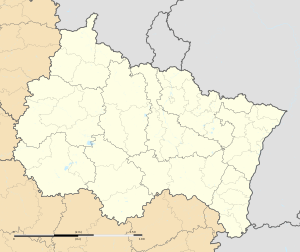Chaumont Viaduct
Coordinates: 48 ° 6 ′ 39 ″ N , 5 ° 7 ′ 17 ″ E
| Chaumont Viaduct | ||
|---|---|---|
| use | Railway bridge | |
| Crossing of | Suize , D65 | |
| place | Chaumont | |
| construction | Stone arch bridge | |
| overall length | 600 m | |
| width | 8.10 m | |
| Number of openings | 50 on the top floor | |
| Longest span | 10 m | |
| height | 50 m | |
| start of building | 1855 | |
| completion | 1856 | |
| planner | Zeiller, Eugène Decomble | |
| location | ||
|
|
||
The Chaumont Viaduct is a double-track railway bridge on the Paris – Mulhouse railway line on the western outskirts of Chaumont in the Haute-Marne department , where it crosses the Suize river valley and the D65 départemental route and three small local roads.
It is at kilometer 260.7 (calculated from Paris, Gare de l'Est ), a few hundred meters after the confluence of the Blesme-Haussignémont – Chaumont railway line and less than a kilometer from Chaumont train station.
It is one of the most important viaducts of the 19th century in Europe.
description
The natural stone masonry viaduct is 600 m long, 50 m high and 8.10 m wide.
It has three floors. On the upper floor there are 50 round arches, each 10 m span , on the second floor 46 arches, each 9.50 m and on the lower floor 23 arches, each 9.25 m span, as the pillars are stronger from floor to floor and thus offer a little less space for the arches on the lower floor than on the upper floors. However, the arches all have a radius of 5 m so that uniform falsework could be used several times. The height of the floors decreases from 19.85 m in the lower floor to 15.15 m in the middle to 15.00 m in the upper floor. While the upper arches are as wide as the deck, the arches of the two lower floors are only 3.00 m wide. Their task is to increase the stability of the pillars and to dampen the vibrations caused by the trains. Inspection routes lead through the bridge on them and through the 2.50 wide and 5.00 m high culverts in all pillars. On the lower floor, the path can also be used by the general public, while on the second floor, like the walkways on the bridge, it is reserved for service personnel.
Each five arches are framed by significantly stronger pillars, the head of which is decorated with four instead of the two otherwise used guttae . These pillars take on the role of abutments and are intended to limit the consequences of the destruction of an arch to this group of 5.
These dividing pillars are 4.30 m wide on the lower level, the other pillars are 2.30 m wide. All the pillars have on the inside under the arches vertical walls, but their width increases by a strong tightening of the 8.10 m on a track, up to 15.88 m at the base.
history
The viaduct was commissioned by the Chemin de fer de l'Est as part of the Paris – Mulhouse railway line . It was carried out in just 15 months between August 21, 1855 and November 25, 1856, according to the plans of engineer Eugène Decomble, who works for the railway company, and his superior Zeiller. At times, up to 2500 workers were active on the construction site, which was often worked day and night. Up to 300 horses, a steam locomotive and five stationary steam engines were in use.
During the Second World War , three pillars were blown up by German troops on August 31, 1944. The gap was closed again by November 1945 with reinforced concrete and natural stone cladding.
Since 2012, the bridge has been illuminated by multi-colored LED headlights at night .
Major maintenance work was and will be carried out on the viaduct in 2016 and 2018.
literature
- Viaduc de Chaumont . In: Ministère de l'Agriculture, du Commerce et des Travaux publics (ed.): Exposition universelle a Londres en 1862: Empire Français. Notices sur les Modèles, Cartes et Dessins relatifs aux travaux publies . E. Thunot et Cie., Paris 1862, p. 158–161 ( full text in Google Book Search).
- Eugène Decomble: Devis explicatif de la construction du viaduc de la Suize à Chaumont (Haute Marne) . In: Auguste Perdonnet, Camille Polonceau, continué par A. Perdonnet et E. Flachat (eds.): Nouveau portefeuille de l'ingénieur des chemins de fer . tape 1 . Eugène Lacroix, Paris 1866, p. 253–300 ( full text in Google Book Search).
Web links
- Chaumont Viaduct. In: Structurae
- La réhabilitation du Viaduc de Chaumont on IMGC.fr (PDF, 5 MB); detailed description of the viaduct, its damage and the renovation measures
Individual evidence
- ↑ Decomble: Devis explicit , para. 4
- ↑ Decomble: Devis explicit , para. 5
- ↑ Decomble: Devis explicit , para. 6
- ↑ Decomble: Devis explicit , para. 9
- ↑ Decomble: Devis explicatif , para. 7
- ↑ Decomble: Devis explicit , para. 10
- ↑ Decomble: Devis explicit , para. 8
- ↑ Decomble: Devis explicatif , para. 9, para. 11
- ↑ Decomble: Devis explicatif , para. 27
- ↑ Decomble: Devis explicatif , para. 59
- ↑ Viaduc de Chaumont, mise en lumière du patrimoine en Haute-Marne on LightZoomLumiere.fr
- ↑ Chaumont: Les Travaux continuent. Communication from the SNCF dated December 12, 2016


